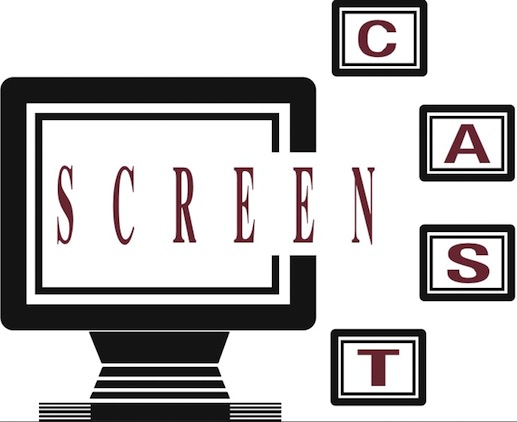
ScreenCast

ScreenCast broadcasted what's
on the display of one NeXTStep computer to one or more
other computers on the same network. Everything that
appeared on the sender's display - typing, window
movements, mouse actions - was simultaneously echoed on the
receiving computers. The number of receivers that could
participate in a ScreenCast session was limited only by
network bandwidth.Under normal conditions, approximately 20
receivers is a practical limit.
The receiving computers could do more, however, than just
echo the image of the sender's display. Each participant in
a ScreenCasc session could also interact with the shared
image. Typing and mouse actions on any machine in the group
appear on all machines.
ScreenCast was perfect for which provided user support
within an organisation. Support personnel can troubleshoot
problems by viewing a copy of the user's display and
watching - or guiding - the user's actions. ScreenCast was
invaluable for performing remote system adminstrarion. The
remote computer could be manipulated as if you were there
in person. ScreenCast was also great for educational
computer labs. Students could easily monitor the
instructor's display by watching their individual computer
screens.
Some important uses of ScreenCast included:
User support. ScreenCast was perfect for providing
user support within an organization. Support personnel
could troubleshoot problems by viewing a copy of the user's
display and watching - or guiding - the user's actions.
Remote System Administration. With ScreenCast,
system administrators could configure or maintain remote
machines from the convenience of their own office. No
longer would they need to walk down the hall or across the
campus for every day administrative tasks.
Education/Training classes. ScreenCast was also
great for educational computer labs. Students could easily
monitor the instructor's display by watching their
individual computer screens. The need for expensive
projection systems was eliminated.
Computer based conferencing. With ScreenCast,
users could talk on the phone while they discuss - and
interact with - the shared display. It didn't matter
whether they were across the hall or across the country.
ScreenCast removed the barriers to truly collaborative
computing.
Customers
Rave About ScreenCast
"ScreenCast has allowed telecommuting to become a
reality for members of our company. There is nothing better
for explaining an idea than grabbing the mouse out of
someone's hand and showing them from 1500 miles away! We
have been able to use it for discussing spreadsheets,
program design, and training from remote sites, a necessity
for a multi-site corporation," said Sean Hill,
Director of Application Development, CCSI Software.
"We are excited by the fact that ScreenCast has the
potential of greatly simplifying the task of training in
the classroom. It essentially does away with the need for
large screen projection which is not always a satisfactory
solution for students sitting in the back of the room.
ScreenCast also adds the dimension of interactivity to the
training environment not present with projection
systems," said Don Baker, Technical Services
Coordinator, Indiana University School of Journalism.
"ScreenCast has been a major time saver for providing
help to remote users on our nationwide network. We are able
to "see" the remote users' screen locally, visualize their
problem, and "show" them the solution to their question
without having to physically go there as was often the case
previously. We plan to license ScreenCast on all our NeXT
machines," said Ron Broersma, Naval Command Control
and Ocean Surveillance Center (NCCOSC).
"I just received v19 (Beta) this morning and I've been
playing with it for the past 2 hours. All I can say is
Wow!!! I'm so excited you can't believe. You have created
something wonderful," said Salvatore Saieva, Unix
Systems Administrator, Queens College.
Features
- The number of receivers that can simultaneously participate in a ScreenCast session is limited only by network bandwidth. (~20 machines is a practical limit).
- Receivers could click on and type in the broadcast windows just as if they were actually on their computer.
- Remote interaction with sender's display could be disabled if desired.
- Broadcasts can be initiated by either the sender or the receiver.
- Receivers could easily switch between viewing the broadcast display and their local display.
- Receivers could be added or subtracted while broadcasting was in progress.
- Broadcasting between color and black and white computers was fully supported.
Requirements
- ScreenCast requires NEXTSTEP 3.0 or later.
- All sending and receiving machines must be running ScreenCast. All must have a valid license.
Price and Availability
Release 1.03 of ScreenCast (supporting both Motorola and Intel hardware) was available directly from Otherwise:
Single user non-floating license: $140
Floating network license:
Number of users Price per user
-----------------------------------------------------------
1 - 9 $160
10 - 19 $150
20 - 29 $140
30 - 39 $130
40 - 49 $120
50 - 59 $110
60 - 69 $100
70 - 79 $90
80 - 89 $80
90 - 99 $70
100+ $65
A 35% educational discount will be given on all prices.
An evaluation copy of ScreenCast could be obtained from the ANDI (Association of NeXT Developers International) InfoServer.
Upon request, it would be sent to you as a 400K NeXTmail attachment.
An evaluation copy ran for three minutes per session unlicensed.
For a more in depth evaluation please contact Otherwise for a one month expiring license.
Otherwise
Otherwise was founded August 1992 by Bill Tschumy, former NeXT software engineer.
Located in Bellingham, Washington, the company developed high-quality NEXTSTEP applications geared toward education.
+++++++++++++++++++++
ScreenCast and Otherwise are trademarks of Otherwise.
Version 1.03 of ScreenCast ran on both NeXT and Intel hardware.
A free 30 day evaluation license was available. ScreenCast would also run unlicensed for 3 minutes, allowing enough time for a quick demonstration of it's capabilities.
Otherwise
$160
Qty in the collection: 0

